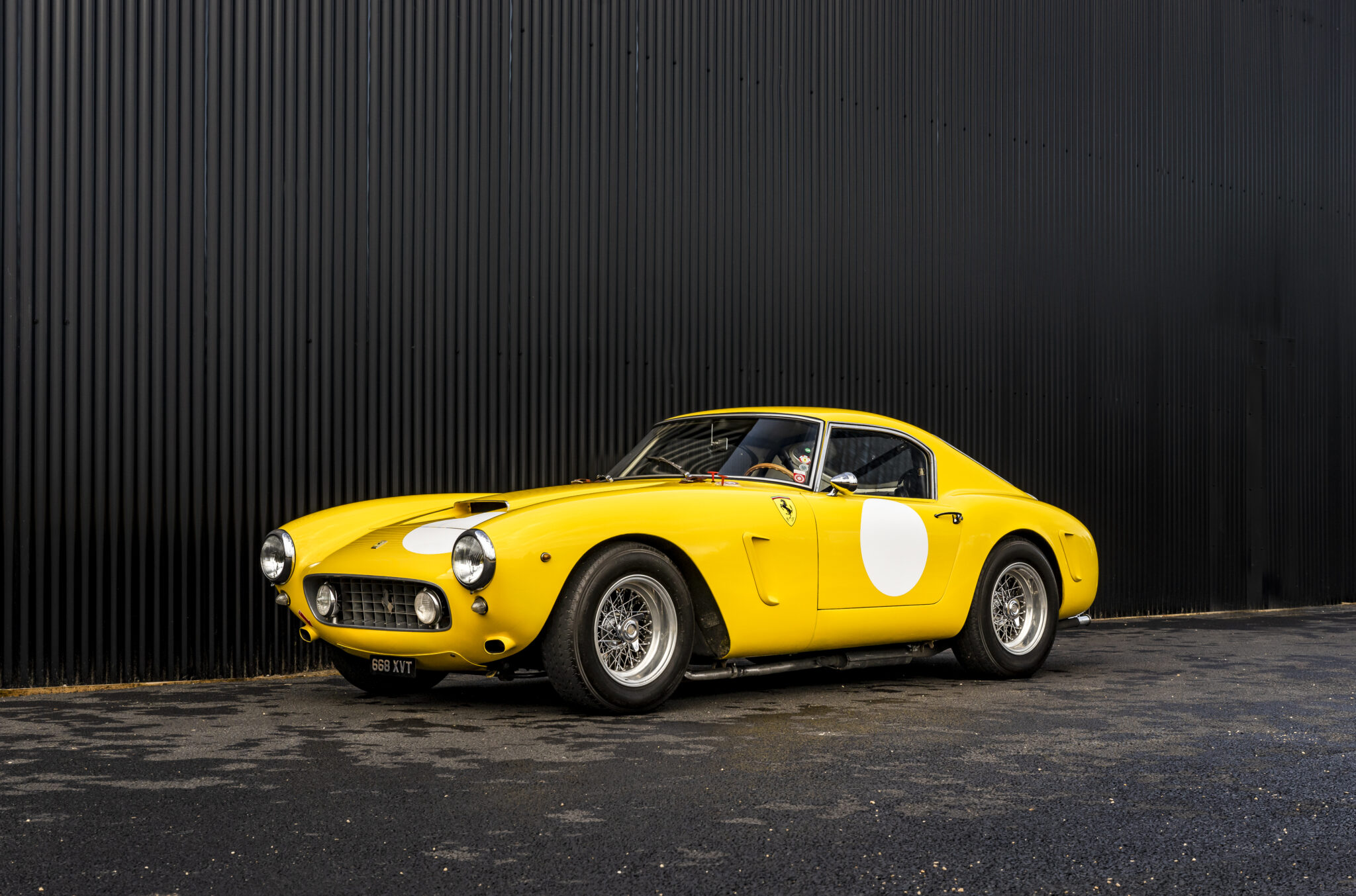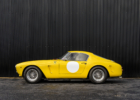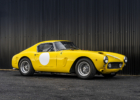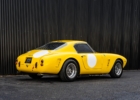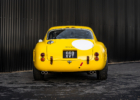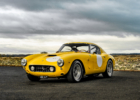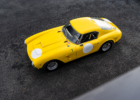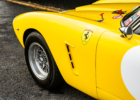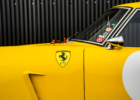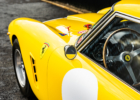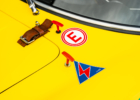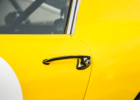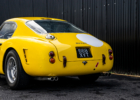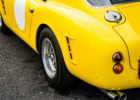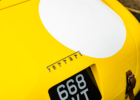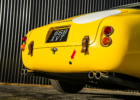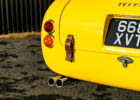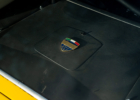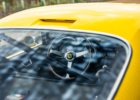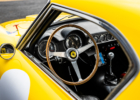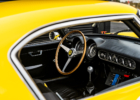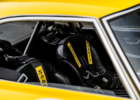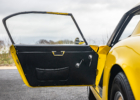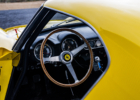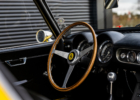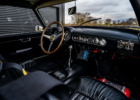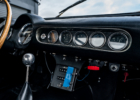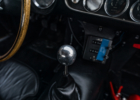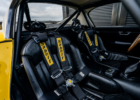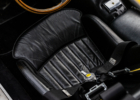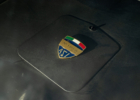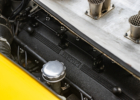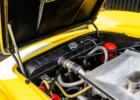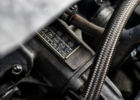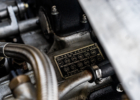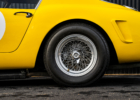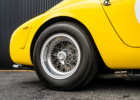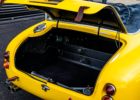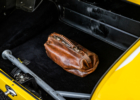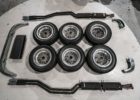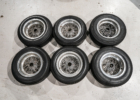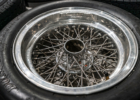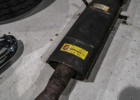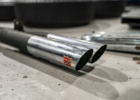1960 FERRARI 250 GT SWB COMPETIZIONE
- 1960 FERRARI 250 GT SWB COMPETIZIONE
- Chassis number: 2177GT
- Engine number: 2177GT
| YEAR | 1960 |
| MAKE | Ferrari |
| PRICE | POA |
VEHICLE DESCRIPTION
Chassis number 2177 GT is a particularly rare example of the Ferrari 250 GT Short Wheelbase. Its frame was sent to Carrozzeria Scaglietti in Modena on 6 September 1960 so that it could receive its hand crafted special order steel bodywork. The competition specification V12 engine – numero interno 612F – was completed on 25 October and it was dyno-tested two days later. The results are noted in the car’s build sheet and show that it produced an impressive 281bhp at 7500rpm.
2177 GT was an unusual steel bodied Competizione model. In that respect, it shares characteristics with 1993 GT and 1995 GT, which were the first two Short Wheelbases to be exported to the UK for British distributor Maranello Concessionaires. The late Richard Colton – the long-term owner of 1995 GT – used to take exception to anyone referring to his car as a Lusso. The history file for 2177 GT includes copies of letters from Colton in which he refers to it as being, in effect, a steel-bodied Competizione in the manner of 1993 GT and 1995 GT. I understand that possibly the Colton car is semi comp engine as per the H & H Catalogue description
The engine therefore featured the high-lift Tipo 130 camshafts, lightweight con-rods and a 9.4:1 compression ratio, while its Weber 40 DCL carburettors had 32mm chokes. The car was also fitted with stiffer springs front and rear, the Competizione ribbed gearbox, a competition exhaust and brackets to accept a quick-lift jack. The window surrounds are in alloy and every conceivable comp feature was originally specified.
The rear axle ratio of 8/32 was well-suited to hillclimb use, and 2177 GT was delivered new on 29 October 1960 to its first owner – a Mr Zimmerman in Switzerland. The supplying dealership was Italauto SA, which was based in Lausanne and was owned by Emmanuel ‘Toulo’ de Graffenried – a former racing driver who won the 1949 British Grand Prix. It’s said that the Swiss hillclimb fraternity preferred the steel body because it was stiffer, harder-wearing and easier to repair than aluminium.
Zimmerman kept 2177 GT until 1962, when he sold it to Armand Boller. Geneva-based Boller was a banker and gentleman racer, and entered the Short Wheelbase for the famous Ollon-Villars hillclimb on 25 August. The event was a round of that year’s European Mountain Championship and attracted a strong field, and Boller finished an impressive fifth in class.
In early 1963, Boller acquired a 250 GTO and would go on to race his latest Ferrari under the banner of Scuderia Filipinetti. Georges Filipinetti was a key figure on the European Ferrari scene at that time, and his competition cars were driven by the likes of Herbert Müller and future Formula 1 star Jo Siffert. Boller was part of that tight-knit group and it’s thought that Siffert might have had at least one outing in 2177 GT in a Swiss event, but so far it has not been possible to prove this theory, he is however mentioned in the Ferrari service sheet.
After Boller bought the GTO, his Short Wheelbase was sold to another Swiss racing driver – Walter Ringgenberg. A Ferrari enthusiast who had previously owned an alloy-bodied 250 GT Short Wheelbase Competizione (1771 GT) as well as a 250 GT ‘Tour de France’, Ringgenberg was a hotelier and restaurateur from Bern. A personal friend of Ferry Porsche, he had raced a 356 during 1953 and ’54 before moving up to a Porsche 550 for 1955. On 18 March that year, he and works driver Richard von Frankenberg used the new car to set six international 1500cc class records at Montlhéry near Paris, and in June Ringgenberg shared it at Le Mans with Hans-Jörg Gilomen.
By the time he bought 2177 GT, Ringgenberg had mostly given up circuit racing preferring hillclimb events, and he entered 2177GT in three events during 1964. In May, he finished third in class at Mitholz-Kandersteg, and went one better at Sierre-Crans-Montana in August. That event was part of the International Championship for GT Manufacturers, in which the GTO was being pushed every inch of the way by the Shelby Cobra, and it therefore attracted a strong entry. Pierre Sudan won the 3-litre class in his GTO with a two-run aggregate time of 15 minutes 6.8 seconds, but second was Ringgenberg, who posted 15 minutes 40.4 seconds in 2177 GT. It was a superb result in such a high-profile hillclimb.
Ringgenberg ended his season with an appearance at Eigental, and in 1966 he sold the Short Wheelbase to a new owner in the US, racing driver, entrepreneur and car dealer Bob Grossman via the Swiss dealership owned by Paul Blancpain and Jo Siffert.
Having grown up in Philadelphia, Grossman settled in Nyack, New York after serving in World War Two. He was a talented singer who used to pay for singing lessons by buying and selling cars – something that soon became his main business.
He acquired a Jaguar dealership via Max Hoffman and got into racing with an XK 120 in Sports Car Club of America events. It was via Jaguar that he got to know Briggs Cunningham, and Grossman would race Lister-Jaguars as well as Lightweight E-types with the renowned American privateer.
He also established a close relationship with Luigi Chinetti and over the years would gain considerable experience with various Ferraris, from an alloy bodied 250 GT California Spyder which he raced to fifth place overall at Le Mans to Short Wheelbases and GTOs. In 1963, Grossman had been elected as president of the Road Racing Drivers Club, an elite group that included a number of the most highly skilled sports car drivers in the United States, and the following year he took a Ferrari GTO (5573 GT) to ninth place overall at Le Mans with team-mate Fernand Tavano.
According to Ferrari historian Marcel Massini, Grossman raced 2177 GT at the Mount Equinox hillclimb in 1966 and after spending some time in the Grossman fleet the car was sold on to fellow racing driver and Ferrari customer from Massachusetts Dudley Cunningham the following year to sit alongside the ex-works Ferrari 340 MM (0322AM) in which talented Marzotto brothers finished fifth overall at Le Mans in 1953.
Cunningham kept 2177GT until 1975 racing it in SCCA events during the early years of his ownership. He sold it – via an advert that claimed it to be ‘ex-Jo Siffert’ – to the Ferrari historian and author Jim Riff, who was based in Illinois. He set about having 2177 GT restored. The process included an engine rebuild, and stripping the Ferrari to bare metal, which showed a remarkable lack of accident damage for a car that had been used in competition. When it was finished, 2177 GT finished second in class at the Ferrari Club of America’s concours in St Louis, having been driven there from Chicago by Jim in the pouring rain!
During Riff’s ownership, the Short Wheelbase was often entered for concours events, and in 1985 he also raced it in a historic event at Elkhart Lake. That same year, 2177 GT appeared on the cover of Ken Gross’s book Ferrari 250 GT SWB, which was published by Osprey.
Riff sold the car in 1986 to California based Tom Byrnes, who raced it in the Monterey Historics weekend at Laguna Seca in 1987 and 1989. Its next custodians were Phillipe Brecht and then Martin Van Doorne, who had the Short Wheelbase restored in 1994-95. Van Doorne later displayed 2177 GT at Ferrari’s 50th anniversary event in Rome and Maranello, before selling it to Geneva-based watchmaker and co-founder of the Swiss Ferrari Club Dr Peter Baumberger.
In 1999, the car was acquired by Austrian Jean-Robert Grellet. Grellet had it repainted yellow and went on to enter the car regularly for events such as the Ennstal Classic, the Giro di Sicilia Revival Targa Florio and the Grand Prix Montreaux. Ferrari also invited 2177 GT to be part of its 70th anniversary celebrations at its Fiorano test track.
Thanks to its incredible versatility as a competition car that can also be driven comfortably on the road, there are those who covet the Short Wheelbase above even the GTO. It certainly continued the level of motorsport success that enthusiasts had come to expect from the 250 GT series. With its Swiss competition history, its rare specification and its fascinating cast of characters, 2177 GT was very much part of this legendary period in Ferrari history.
MODEL HISTORY
During the 1950s and early 1960s, Ferrari developed its line of 250 GT Berlinettas to the extent that the model came to dominate the Gran Turismo class of international motor racing. From the first 250 GT to the fabled GTO, the marque undertook a near-constant process of evolution that was well suited to the demands of top-level competition, and included in that period are some of the most coveted cars ever to roll out of the Maranello factory.
The first Ferrari to use the ‘250’ designation was the 250 Sport, the model in which Giovanni Bracco won the 1952 Mille Miglia – and it was in honour of that momentous victory that Ferrari introduced the 250 MM the following year. Then came the 250 Europa, which used the Aurelio Lampredi-designed ‘long block’ V12 engine and a chassis that had a wheelbase of 2800mm.
At the 1954 Paris Salon, Ferrari unveiled the 250 Europa GT, and this was the car that really laid the foundations for the subsequent 250 GT. Beneath the bonnet was a 2953cc development of the V12 engine that Gioacchino Colombo had originally designed for Enzo Ferrari during the summer of 1945. It was mounted in the Tipo 508 chassis, which had a wheelbase of 2600mm and would form the basis of all 250 GT Berlinettas until 1959, with minor modifications along the way leading to the adoption of a B, C or D suffix.
The Scaglietti-built 250 GT Berlinetta was introduced in 1956 and used the latest Tipo 128 development of the Colombo V12 engine. It retained the 2953cc capacity, but the block, cylinder liners, cylinder heads and crankshaft were all new, as were the camshafts, and bigger valves were used. This engine survived until well into the 1960s, being modified for use not only in the 250 GT series, but also forming the basis for the engines that would power the 250 Testa Rossa, the 250 P and the 250 LM.
The 250 GT Berlinetta would go through myriad detail changes over the course of the next few years, but those built between 1956 and 1959 have come to be referred to as the ‘Tour de France’ model because of their success on that gruelling French event. In fact, variants of the 250 GT would go on to win every year between 1956 and 1964.
Its success on the Tour de France was only a small part of the extraordinary 250 GT story. The Berlinetta swept aside the opposition pretty much everywhere it raced. In 1956, Olivier Gendebien finished fifth overall on the Mille Miglia, and won the GT category ahead of a quartet of Mercedes 300SLs. The Belgian ace repeated that success the following year, winning the gruelling Giro di Sicilia and the Reims 12 Hours.
In 1959 came the next major development, with the appearance at Le Mans of a model that retained the Tipo 508 chassis but which introduced a new Pinin Farina body style that would be carried over to the 1960 250 GT.
Battista ‘Pinin’ Farina had founded his eponymous business on 22 May 1930 in Turin, and it made a name for itself with flowing, aerodynamic designs for manufacturers such as Lancia and Alfa Romeo. This was not a man who held Enzo Ferrari in any sort of awe or reverence – when Enzo first got in touch in 1951, story has it that Farina expected him to travel to Turin. Enzo, in turn, expected Farina to travel to Maranello, and the impasse was broken only when Battista’s son Sergio suggested that they meet halfway, in Tortona. The first Ferrari to wear a Pinin Farina body was a 212 Inter, and by 1958 the company had become successful enough to build a larger plant at Grugliasco.
The Pinin Farina-designed 1959 250 GT was, in effect, a hybrid – new body on old chassis – and would therefore become known as the ‘Interim’ model. Only seven were built, with the car of André Pilette and George Arents finishing fourth overall in that years Le Mans 24 Hours race.
After that short run of ‘Interim’ models came the definitive 1960 250 GT. Launched at the Paris Salon in October 1959, this latest development formed another major step in that it used the new Tipo 539 chassis. Although it was outwardly similar to the Tipo 508, it was stronger and stiffer than before – and most importantly the wheelbase had been reduced from 2600mm to 2400mm. That led to it being unofficially dubbed Passo Corto – the Short Wheelbase.
Unlike earlier Berlinettas, The 250 GT Short Wheelbase was available in right or left-hand drive and owners had the choice of either a race-ready Competizione variant, featuring a host of competition features to include an aluminium body, sparsely trimmed interior and more highly tuned engine, or the Lusso, with its steel body, fully trimmed cockpit and a less powerful V12. The car could be truly ordered in bespoke fashion to the customers demands and in reality, it was common for buyers to ‘mix and match’ between those two specifications.
The earliest Short Wheelbases were all left-hand-drive Competizione models and had plain front and rear wings with no air vents, and there was an air outlet in the rear screen. The top edge of the doors, meanwhile, curved noticeably downwards towards their rear edge.
On cars built between May and August 1960, air vents appeared in the front and rear wings, indicators were added to the front wings, and projecting surrounds were added to the brake cooling ducts in the front valance. There was now a proper housing for the rear numberplate, and the first Lusso and right-hand-drive models left the factory. On cars built between August and December 1960, the vent in the rear screen was moved up to the trailing edge of the roof.
In 1961, the front grille was made larger, the top edge of the door windows was straighter rather than curving downwards and the petrol filler cap was moved from below the bottom-left corner of the rear screen to a new position on the left-rear wing; on some cars, it was tucked away inside the boot.
The engine was a further development of the outside-plug Tipo 128DF that had been used in three of the ‘Interim’ 250 GTs. The block and many of the internals were carried over, but new cylinder heads were used with larger coil-sprung valves. This latest variant of the V12 was called the Tipo 168B, and it produced up to 275bhp; Lusso models made do with a lower compression ratio and about 240bhp.
In late 1960, the engine was updated into Tipo 168 form and during the following year came its ultimate development – the Tipo 168 Comp/61. This unit had Testa Rossa-style cylinder heads with larger valves, the manifolds lengths were altered and larger-bore exhaust pipes used. A trio of Weber 46DCF3 carburettors was employed and the sump was made of Elektron.
The Short Wheelbase continued the heady run of motorsport success that had been enjoyed by the 250 GT series since 1956. In 1960 and ’61, Stirling Moss won the Tourist Trophy at Goodwood aboard Short Wheelbases entered by his great friend Rob Walker and described it as a ‘beautiful handling car’. Willy Mairesse and Georges Berger won the Tour de France in both of those years, while the Short Wheelbase enjoyed further success in events such as the Nürburgring 1000km, Paris 1000km and the Le Mans 24 Hours. Fernand Tavano and Pierre Dumay won the GT class at La Sarthe in 1960 and finished fourth overall, while Pierre Noblet and Jean Guichet claimed class honours the following year and were third overall.
By 1961, the Prancing Horse was dominant in each of the top-line international disciplines. Phil Hill became Formula 1 World Champion, Ferrari won four of the five rounds of the World Sports Car Championship, and the Short Wheelbase had firmly established itself as the benchmark in GT racing – despite the best efforts of Aston Martin and Jaguar.
With its beautiful Pinin Farina styling, robust and sonorous Colombo V12, and a level of versatility that allowed it to be driven to a circuit, racedhard to victory, and then driven home again, it’s little wonder that the Short Wheelbase has become one of the most revered and sought-after Ferraris of all time.
ENQUIRE NOW

Car Storage In The Cotswolds
OXFORDSHIRE • GLOUCESTERSHIRE • COTSWOLDS
